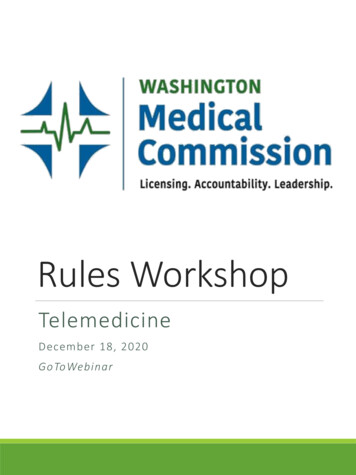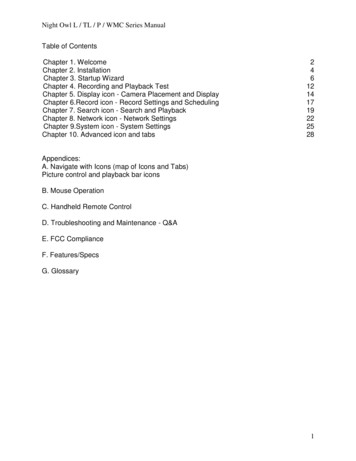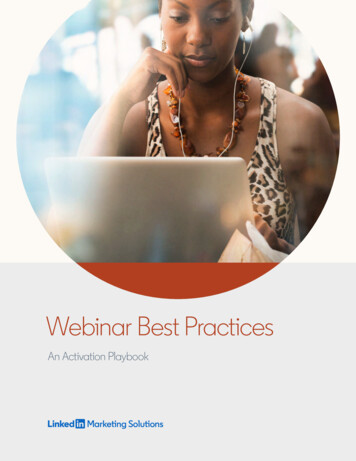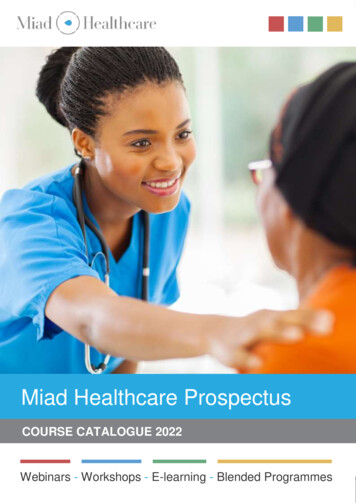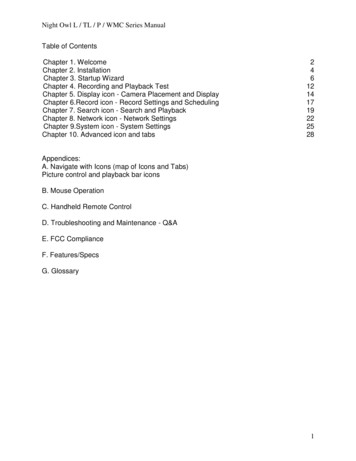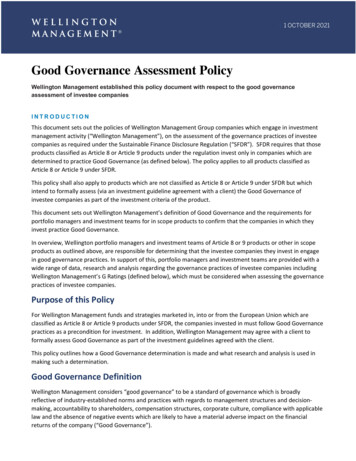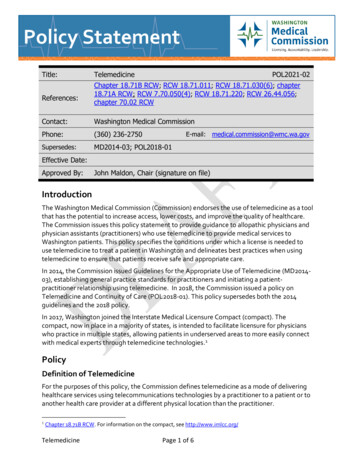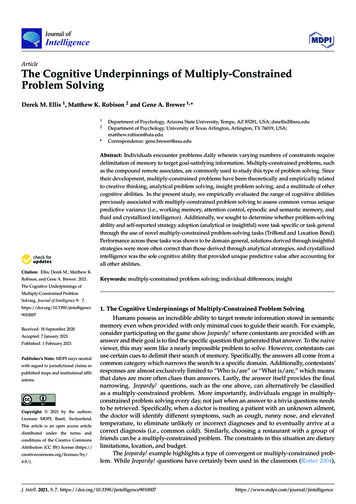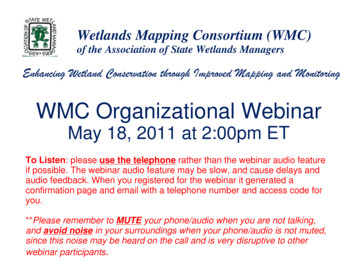
Transcription
Wetlands Mapping Consortium (WMC)of the Association of State Wetlands ManagersEnhancing Wetland Conservation through Improved Mapping and MonitoringWMC Organizational WebinarMay 18, 2011 at 2:00pm ETTo Listen: please use the telephone rather than the webinar audio featureif possible. The webinar audio feature may be slow, and cause delays andaudio feedback. When you registered for the webinar it generated aconfirmation page and email with a telephone number and access code foryou.**Please remember to MUTE your phone/audio when you are not talking,and avoid noise in your surroundings when your phone/audio is not muted,since this noise may be heard on the call and is very disruptive to otherwebinar participants.
Wetlands Mapping Consortium (WMC)of the Association of State Wetlands ManagersEnhancing Wetland Conservation through Improved Mapping and MonitoringWMC National Organizational WebinarMay 18, 2011Jeanne Christie (ASWM)Jane Awl (ASWM)John Galbraith (VTI)Megan Lang (USDA)
Wetland Mapping Consortium (WMC) Formed in partnership with the Association of State WetlandsManagers (ASWM) and Virginia Tech. The WMC is an interdisciplinary group of wetland scientists andmanagers interested in mapping and monitoring wetlands withremotely sensed images and/or using the resultant products to bestmanage wetland resources. Goal is to improve the management of wetland resources throughenhanced wetland mapping and monitoring and dissemination of thisinformation.
WMC 2011 Organizational Meetings(1) SWS - SAC/MAC Joint Chapter Meeting (March 8, 2011)(2) State/Tribal/Federal Coordination Meeting (March 23, 2011)(3) WMC National Organizational Webinar (May 18, 2011)(4) Establishing a Formal Framework for WMC (TBA Fall 2011)
AGENDA Welcome and Introductions (Jeanne Christie) Background (Jane Awl) Easily Restored Wetlands Project (John Galbraith) Purpose (Megan Lang) Next Steps (Jeanne Christie) Wrap-up (Jeanne Christie)
Wetland Mapping Consortium (WMC)Background
Why is the WMC needed? The ability to map and monitor wetland extent and the fundamentaldrivers of wetland function is evolving rapidly. Enhanced communication amongst and between scientists andmanagers is necessary to improve the awareness of new remotesensing tools and techniques capable of solving many of our mostintractable wetland management challenges. Enhanced communication will prevent duplication of fundedresearch efforts and allow the leveraging of resources andexpertise. Cooperative, synergistic, interdisciplinary research fundingproposals and projects may be initiated that overcome limitationsat a single institution or agency.
Original Proposed WMC Activities: Build collaborative teams to enable rapid andthorough response to calls for proposals. Organize a pool of experts who can respondto requests for more information aboutwetland mapping techniques andtechnologies.
WMC Membership 2011 140 Individual Members as of May 2011 Working groups currently using the site include: Wetlands Mapping Standard Workgroup (WMSWG) Wetlands Classification Standard Maintenance WorkingGroup (WCSMWG) Coastal and Marine Ecological Classification StandardWorking Group (CMECS) Southeast Wetland Workgroup (SEWWG)
WMC Projects 2009-2011 WMC Scholar Site and Entry Webpage–Online Collaborative Resources Hosted wetland mapping sessions at professional meetings (mostrecently at SWS SAC/MAC Joint Chapter Meeting (March 2011) National Wetlands Newsletter article series (September-October 2009and September-October 2010) Technical support for FGDC Wetlands Mapping Standard andWetlands Classification Standard Implementation PlanOnline TrainingWetlands Classification Image Gallery –Online image collectionNEW in 2011: Calling All Wetlands Project and iPhone appNEW in 2011: Technical Guidance on Unique Identifiers forWetlands Easily Restored Wetlands project –soil data shared via hard drive
WMC Online Resourceshttp://clic.cses.vt.edu/WMC/
WMC Online Resourceshttp://clic.cses.vt.edu/WMC/Utilizes Virginia Tech’s Scholar Site https://scholar.vt.edu/portal basedon the Sakai Project (http://sakaiproject.org/) open source suite of learning,portfolio, library and project tools.Collaborative resources include: File Sharing Discussion Forums Email Lists Chat Room Events Calendar Blogs Announcements Polls
Can the WMC helpyour project move forward? Utilize WMC communication tools and resourcesto foster collaboration. Individual project resource areas and memberlists, such as for working groups, can be set upwithin the WMC.
Wetland Mapping Consortium (WMC)Easily Restored WetlandsProject
Easily Restored Wetlands project Hydric soil data (SSURGO) is not readily available nationwide as a single shapefile.Also, the vector format is not always desirable for merging with other data layers. Sharon Waltman, USDA-NRCS, Norman Bliss USGS et al. have developed a griddedversion of SSURGO spatial data in three pixel sizes for the Conterminous UnitedStates. The gridded SSURGO can be used with a database query look up table. The current database query identifies "Potential Wetland Soil Landscapes “ andincludes more than just hydric soils (component "hydricrating Yes“) from theSSURGO data source. This query needs review by WMC to determine usefulness toidentify easily restored wetlands. The gridded SSURGO spatial data is currently provided on a hard drive to share withusers. Bill Wilen of USFWS will direct the fate of the hard drive as it moves betweenagencies. The data is desired to be refreshed at the end of each calendar year, and posted to asite for optional upload. ASWM is making arrangements for serving the data online. The Wetlands Mapping Consortium Scholar site hosted at Virginia Tech can be usedto build a set of interested users and a request list for tables and fields not provided inthe first version (Aug. 1, 2010).
Easily Restored Wetlands projectRequested data: SSURGO geodatabase file and the sequel server download,and the selected tables (Spatial, Chorizon, Cohydriccriteria,Comonth, Cosoilmoist, Ksat, Component, Legend, Mapunit). 10, 30, and 100 meter gridded SSURGO 12/30/2009 for eachstate (Albers Equal Area - AEA projection) FGDB that includes the full 12/30/2009 SDM snapshot forreference 2001 NLDC (in AEA) (optional) NASS CDL, if an AEA version Results of final query of 12/30/2009 SDM tables Results of query from NSSC, USDA-NRCS, Lincoln, NE andMorgantown, WV.
Wetland Mapping Consortium (WMC)PURPOSE
WMC General PurposeWMC fosters collaborations and disseminatesdata and findings for the purpose of enhancedwetland mapping and monitoring.
WMC Long-term GoalTo improve the management of wetland resourcesthrough enhanced wetland mapping andmonitoring, ultimately resulting in increasedconservation of wetlands and the enhanced deliveryof wetland ecosystem services via the evaluation ofwetland properties and the dissemination of thisinformation to natural resource managers.
What do you view to be the mostvaluable role of the WMC? Posting of solutions (or case studies) for difficult problems. Access to expertise involving geospatial datasets. Access to an open forum where challenging issues could beaddressed by multiple experts. Encouraging collaboration between not just scientists butmanagers, etc. Organizing the mapping community – both mappers and datausers. Sharing information and discussing new technology. Informing folks as to what kinds of data are available in theirstate. Cooperative, synergistic, interdisciplinary research proposals thatovercome limitations at a single institution or agency. Other?
What are the most important thingsthat can be done in the near-term tohelp achieve our long-term goal? Regular newsletters or conference calls? Links to journal articles and white papers? Training material? Links to data? Network of topical experts? Other?
WMC Organizational MeetingDiscussion QuestionsSOURCES:(1)SWS - SAC/MAC Joint Chapter Meeting (March 8, 2011)(2) State/Tribal/Federal Coordination Meeting (March 23, 2011)
WMC Organizational Meeting Discussion Questions1. What is the greatest current challenge for the wetland mapping community? Knowing whether or not the wetland exists and size. Can’t always trust NWI andaccuracy varies according to landscape and wetland type. Accurate categorization and isit jurisdictional? Big concern on number or area of omitted wetlands. (1) How do we reconcile SSURGO hydric soils (overestimation) and NWI(underestimation)? (1) Access to data sets. John has data envy. Greg Snyder – lead for LiDAR coordination.(1) Consistency and accuracy once mapping is farmed out to states and contractors. (1) Resources/Funding (2) Training (2) Knowledge of new and developing technologies (2) Developing contracts to meet the new mapping standards – knowing the right questionsto ask and the right limitations/guidelines to set. (2) Need guidance as to what should be in an RFP. Sub-standard maps could be a hugeissue on multiple fronts. (2) What should we expect to pay for a good product? (2) Do we need a wetland mapping certification process? (2) How much can be automated without losing quality assurance? (2) USFWS quality control of data – how can this be done with limited staff? (2)
WMC Organizational Meeting Discussion Questions2. What do you view to be the most valuable role of the WMC? Posting of solutions to difficult problems. Access to expertise involving geospatialdatasets. Access to an open forum where challenging issues could be addressed bymultiple experts. (1) Encouraging collaboration between not just scientists but managers etc. AWRA couldbe contacted. (1) Organizing the mapping community – both mappers and users (2) Sharing information and discussing new technology (2) Can we inform folks as to what kinds of data are available in their state? (2)3. What would be the most effective way to organize the consortium, or whatshould the organization structure look like to best serve the needs of the mappingcommunity? Keep it simple; board structure (2)
WMC Organizational Meeting Discussion Questions4. In addition to what is on the WMC Scholar site now, are there additionaltechnical resources that are needed by the mapping community? Links to journal articles and white papers? Training material. Links to data servers. (1) Regular newsletters or conference calls. Links to research sites. (1) Announcements of updates to wetlands layer would be helpful. (2) Thresholds for mapping farmed wetlands? How wet is wet enough? How do you judgethis remotely? (2) Mapping or data on farmed wetlands (tiled and drained) or difficult to map wetlands?Tips, strategies? (2)5. Are there other people we should be sure to invite to be part of the WetlandMapping Consortium? Need to invite active wetland mappers. Need a distribution list. (2) Policy regarding commercial groups? Can access be limited for commercial folks? (2)
WMC Organizational Meeting Discussion QuestionsNO COMMENTS TO DATE:6. What are the most important new opportunities to use wetland maps in decision making?7. What different kinds of imagery are becoming available and how suitable are they forwetland mapping? Who is trained in using them? What training is needed ?8. Are you engaging in or know of studies, pilot projects, projects, etc. you would like toshare with the larger mapping community?9. What challenges occur trying to adopt the new FGDC wetlands mapping standard?10. How much training is needed to map or do qa/qc to ensure maps will meet the new FGDCwetland mapping standard?11. What should be included in an RFP on wetlands mapping; what should reviewers look forto ensure the mapping project will meet the new standard (can a bid be so low that theproject will be poor quality)12. Should NAPP ever be used to map wetlands? (obviously is it being used, but there aresome real concerns). If so, when and what other data should be used to provide ancillaryinformation to ensure mapping project will meet the new standard.13. Is there publicly available GIS information that would assist in wetland mapping but isstill hard to get?
Wetland Mapping Consortium (WMC)NEXT STEPS
What should the WMC organizationalframework be? A consortium without any formal stucture? A consortium with an informal board? A consortium with an elected board? A formal 501 (c ) (3) Organization? Other?
How will WMC Activities andPresentations be identified? Ad hoc – individual members organize asneeded? Formal or informal board? Committee or project leaders? Quarterly meetings to collectively identifyand report on projects? Other?
WMC Proposed Webinar Schedule June or July – TRAINING: Using the WMC ScholarWebsite June - Unique Identifiers for Wetlands July - "Calling All Wetlands" Project (& iPhoneapp for uploading photos from the field August – Easily Restored Wetlands Project September – Establishing a Formal Frameworkfor the Wetland Mapping Consortium Other?
Wetland Mapping Consortium (WMC)BRAINSTORMINGSESSION
Wetland Mapping Consortium (WMC) Next Steps Volunteers Final Thoughts
Wetland Mapping Consortium (WMC)Wrap-up
Contact Informationsend general email to wetlandmappingconsortium@gmail.comJeanne ChristieAssociation of State Wetland Managersjeanne.christie@aswm.org(207) 310-8708Jane AwlAssociation of State Wetland Managersjane.awl@earthlink.netMegan LangUSDA Forest Service Northern Research Stationmwlang@fs.fed.usJohn GalbraithVirginia Techttcf@vt.edu
Wetland Mapping Consortium (WMC)Helpful Links: ASWM State Wetland Mapping page: http://aswm.org/wetland-science/wetland-mapping Wetland Mapping Consortium: http://clic.cses.vt.edu/WMC/ Using the Wetland Mapping Consortium (WMC) Scholar Site: http://aswm.org/pdf lib/using the wmc scholar site 062310.pdf
Wetland Mapping Consortium (WMC)Thank you!
Wetland Mapping Consortium (WMC)AdditionalMaterial
Excerpt from National Wetlands Newsletter; September-October 2009, (31:5) page 9.
National Wetlands NewsletterSeptember-October 2009, (31:5) pages 6-1139
National Wetlands NewsletterSeptember-October 2010, (32:5) pages 10-17 and 36-37
Wetlands Mapping Standard was endorsed by FGDC in Wetlands%20Mapping%20Standard final.pdf)Wetlands ClassificationStandard Classification ofWetlands and DeepwaterHabitats of the United States(Cowardin et al, 1979)endorsed by FGDC in 1996, iscurrently in /FGDC-standardsprojects/wetlands/index html)
Role of Wetland Mapping Consortium (WMC)Identified in FGDC Wetlands Mapping StandardImplementation Plan Fostering collaborations Providing on-going support for implementingnew technologies Adding discussion group capabilities to addresstechnical challenges Developing new applications to meet the needsof decision makers
Wetlands Classification Image Gallery
WMC Organizational Webinar May 18, 2011 at 2:00pm ET To Listen: please use the telephone rather than the webinar audio feature if possible. The webinar audio feature may be slow, and cause delays and audio feedback. When you registered for the webinar it generated a confirmation page and email with a telephone number and access code for you.
